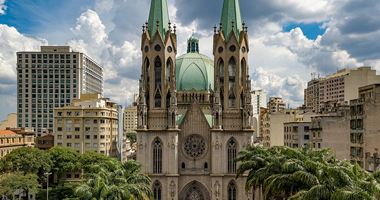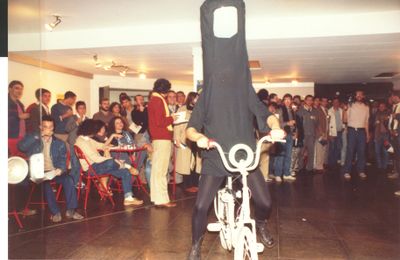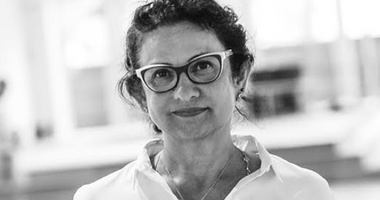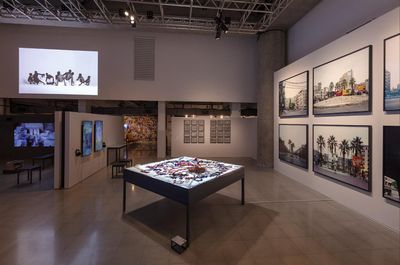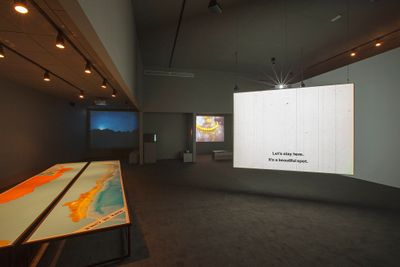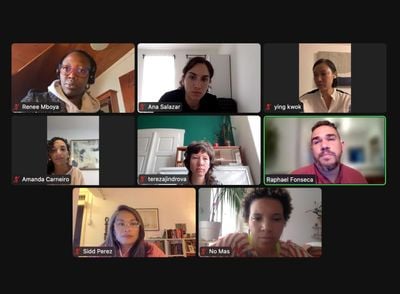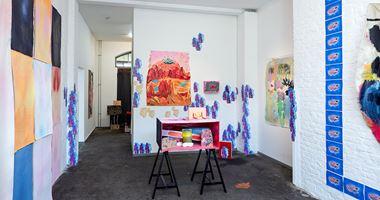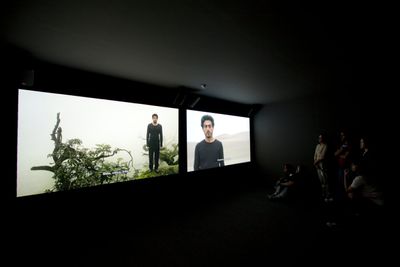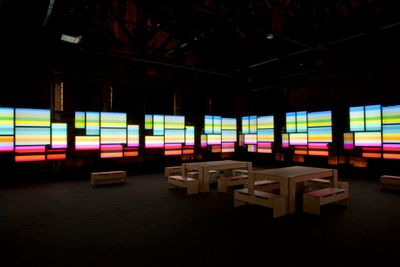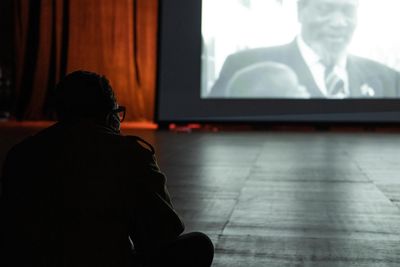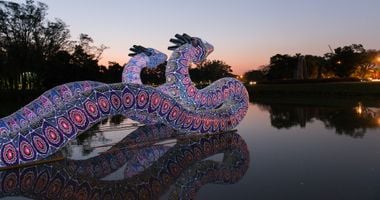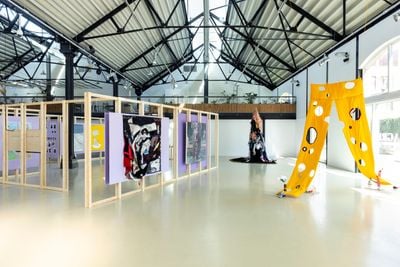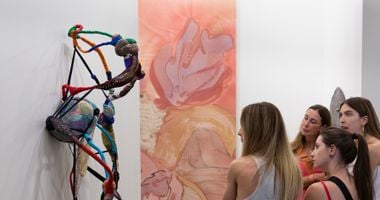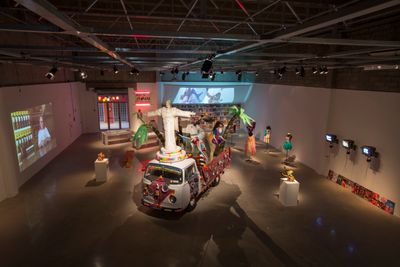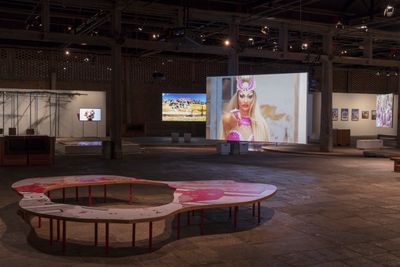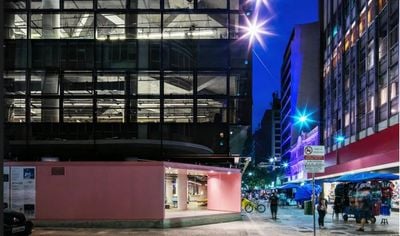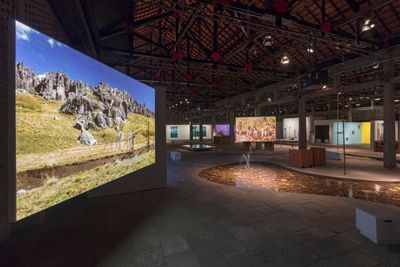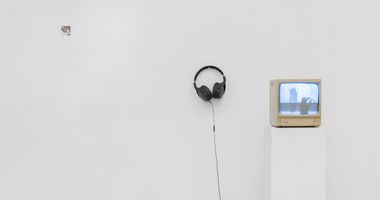Raphael Fonseca and Renée Akitelek Mboya on Memory-Making at Sesc_Videobrasil
Sponsored Content | SESC_Videobrasil
Marcellvs L., Toga (2010). Exhibition view: 17th International Contemporary Art Festival Sesc_Videobrasil, São Paulo (30 September–1 December 2011). © Videobrasil Collection and Everton Ballardin.
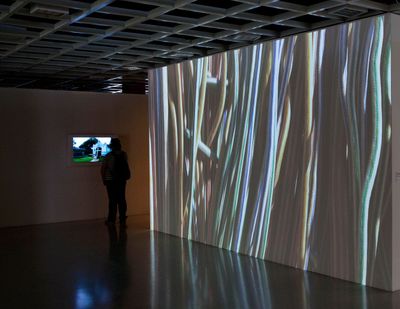
Marcellvs L., Toga (2010). Exhibition view: 17th International Contemporary Art Festival Sesc_Videobrasil, São Paulo (30 September–1 December 2011). © Videobrasil Collection and Everton Ballardin.
Faced with more than 2300 artist applications, curators Raphael Fonseca and Renée Akitelek Mboya, together with Videobrasil artistic director Solange Farkas, are in the midst of a monumental selection process for the 22nd Biennial Sesc_Videobrasil.
The exhibition's title, Memory is an Editing Station, is drawn from a verse by Brazilian poet Waly Salomão in a body of work that responds to post-dictatorship Brazil. Scheduled for October 2023 at Sesc 24 de Maio in São Paulo, the 40th anniversary edition takes place after a fraught period under Bolsonaro's presidency that saw the dissolution of the Ministry of Culture and dramatic cuts to arts funding.
Founded in 1983, two years before the end of the military dictatorship, Videobrasil was first set up as an annual festival of video art by Brazilian artists at the theatre of São Paulo's Museum of Image and Sound. At a time of tight state control on broadcast licences, the exhibition responded by finding new space for the expression and dissemination of alternate perspectives.
Through the decades, Videobrasil has reinvented itself time and again, embracing internationalisation while remaining attentive to its locality. In the early 1990s, it opened up to artists from regions with shared experiences of political and cultural oppression, with a focus on the geopolitical South. However, as Videobrasil's founder and artistic director Solange Farkas emphasises, 'our definition of the Global South has never been fixed to its geographical boundaries, always destabilising what is considered "the South" in the complex field of hegemonic artistic production.'
Significant to Videobrasil's endurance has been its partnership with Sesc, short for Serviço Social do Comércio (Social Service of Commerce), a private institution that has facilitated the opening of public spaces for promoting and disseminating art and culture in Brazil since 1947. Maintained by commercial entrepreneurs, Sesc currently counts more than 44 units in São Paulo and began its relationship with Videobrasil in 1992, which continues with the Sesc Director, sociologist, and cultural manager Danilo Santos de Miranda.
Despite only taking on the name of a biennial in 2019, as a result of its scale and the necessity to space exhibitions out, Videobrasil continues to support experimentation and avantgarde practices that are being made on the fringes of the dominant global art circuit.
At the turn of the millennium, the platform started to expand its focus to interdisciplinary practices, beginning with the exhibition Possible Narratives – Artistic Practices of Lebanon—held during the 14th Videobrasil edition—in 2003. Curated by Christine Thomé and Akram Zaatari, Possible Narratives featured works by artists such as Lamia Joreige, Gilbert Hage, Marwan Rechmaoui, Jalal Toufic, and Walid Raad, spanning photography, performances, video, and publications, that explore Lebanese identity in the aftermath of the Civil War (1975–1990).
In 2011, Videobrasil's annual exhibition opened up to different media, now including installations, performances, photographs, paintings, and artist books in addition to video and electronic art.
The establishment of Videobrasil's collection, a monumental archive of more than 3,000 works featuring important Brazilian artists such as Rosangela Rennó, Marina Abs, Rafael França, and Eder Santos has also become a key aspect of the platform. Unerasable Memories, a major exhibition curated by Agustín Pérez Rubio in 2014, addressed histories of erasure and their ongoing impact on violence in the present with works from the collection, including those of Jonathas de Andrade, León Ferrari, and Aurélio Michiles.
Tapping into Videobrasil's legacy of video and the medium's inextricable associations with the passage of time and memory, Fonseca and Mboya's call-out for the 22nd edition asks, 'What are the ethical boundaries of a cut? Who holds the power to do so? How to forge the memory of what we didn't see or feel in our bodies? What are the limits of memory?'
Fonseca and Mboya are now in the process of selecting works for the 22nd Biennial Sesc_Videobrasil with the input of seven other international curators, among them Amanda Carneiro, from the São Paulo Museum of Art; Tereza Jindrová, a critic and curator based in Prague; Nomaduma Rosa Masilela, one of the curators of the 10th Berlin Biennale alongside Gabi Ngcobo; Siddharta Perez, from NUS Museum in Singapore; Ana Salazar, curator and co-founder of Museum for the Displaced, a 'para-institution' addressing issues of forced migration through art; and Ying Kwok, from Hong Kong's Tai Kwun.
In this conversation, Fonseca and Mboya share their experience of the selection process, their own curatorial standpoints, and how they seek to find a balance between the exhibition's locality and its global outlook.
TMIn 1983, Videobrasil was set up with a focus on video and multimedia by artists from the geopolitical South. The exhibition has since expanded to encompass multiple media, and perspectives on and from the Global South remain dynamic and ever-changing. Could you tell me a bit about how you are engaging with these legacies for the upcoming 40th anniversary edition?
RFVideobrasil has changed a lot over the years. I'm not from São Paulo, I'm from Rio, and the first edition I ever saw was in 2011. What I think is interesting is that when it was first conceived, it wasn't a biennial—it was an annual festival dedicated to video, and only by Brazilian artists.
The first edition dedicated to the Global South was in 1992. After that, lots of artists from across the Southern Hemisphere started to get involved, and in 2011, Solange decided to expand the focus beyond video. Since 2019, it has taken the form of a biennial.
Renée and I have discussed extensively about how we might deal with its history, not just in the exhibition but also in the public programmes and publication. In the aftermath of the pandemic, it's important to rethink how video has become the main medium of our lives, whether interacting online, watching YouTube, playing games, and so on. Any curator dealing with Videobrasil will be concerned with these developments.
TMThe title of the 22nd edition, Memory is an Editing Station, is drawn from the poem 'Open Letter to John Ashbery' by Waly Salomão. It is published in his book Algaravias: Echo chamber (1995), which includes reflections on interactions between humans and technology as well as the years after the dictatorship in Brazil—the context in which Videobrasil originated. I'm interested in the conception of memory here, as something intangible, yet an 'editing station' suggests that one can take control of it. Could you expand on this idea, and how these editing stations will be translated in the exhibition space?
RAMHow you think of memory depends on your cultural position, in terms of your background and where you come from. Memory is perceived differently across cultures. In the context of where I come from, in Kenya, and many similar cultures from my region, memory is something that is malleable, and that is subject to constant change.
It's almost like a fiction that exists and is subject to state control and then becomes a certain truth once a governing body decides what it will be. I think that will be an interesting aspect of the exhibition—the different perspectives on what a memory can be, what our editorial agency of memory-making is, and what its use can be.
I was watching a film yesterday by Jean-Pierre Bekolo, La Grammaire de ma Grand Mère (1996), in which director Djibril Diop Mambéty speaks about the different grammars that exist. One of the things that Mambéty says is, 'Once upon a future'.
I think it's an interesting idea to think about what it might mean to project memory into a future space and then reorient the vocabulary of it. We're in the midst of the selection process for the exhibition, so we're seeing lots of interpretations of what memory is and what it can be.
RFIt's also curious to see how different artists from different cultures, but also generations, are dealing with the idea of memory. For example, we have artists working with footage and collages of archives, as well as artists working with CGI, who are dealing with the idea of the archive being estranged from them, and of memory as a whole invention. There are many interesting ways to deal with these concepts and ideas.
TMFilm itself reflects that malleability that you were referring to earlier, Renée, in terms of how images can be cut and arranged. That potential speaks to the questions within the exhibition's call-out, which asks, 'What are the ethical boundaries of a cut? Who holds the power to do so? How to forge the memory of what we didn't see or feel in our bodies? What are the limits of memory?'
These questions make me think of your work with film and memory, including A Glossary of Words My Mother Never Taught Me (2021)—your linguistic and visual subversion of the sensationalist 1966 film Africa Addio. You also addressed the film in a curatorial essay titled And Salt The Earth Behind You (2021), which documents the 1966 protest by Black students at Astor Cinema in Kurfürstendamm around the screening of Africa Addio.
Given Sesc_Videobrasil's past focus on video, could you tell me a bit about how your own filmic practice will feed into your and Raphael's curatorial vision?
RAMI think I should clarify that I don't consider myself to have a filmic practice, per se. In my work, I have been interested in activating and mobilising colonial archives. I came to it with the same ethic as Solange might have had in 1983, approaching a new medium that is relatively mobile and that is easily translatable or transferrable, and makes people feel that they are in the moment of occurrence. The easiest way for me to think about reanimating these archives was to put them back in the timeline and see how they might be mobilised, particularly as I work with quite violent material.
I think a huge priority for me is to think about citation as a process of building social and political legacies that honour a past and a future within which all of us can visualise ourselves. Historically, video requires a community to make it, but we don't necessarily acknowledge the people involved. And my anxiety is that the first people to fall out of citation are Black women; queer Black women especially.
Raphael and I go back and forth a lot about this idea of the Global South, and whether or not it's significant to this generation of artists and whether or not it can be projected onto a reality in which we collectively find ourselves, on the internet. As Videobrasil globalises, how does it acknowledge the things that are urgent within the local context of São Paulo, which is made up of a very dynamic and global community?
So, how do we acknowledge the legacies from which we come? It requires a balance. I think video gives us access, but it also prescribes some limits.
TMThinking about the local context, I wanted to ask you, Raphael, about your past work on Brazilian identity and politics. I'm thinking, in particular, of your PhD on the iconography of the hammock in relation to Brazilian culture, as well as your recent exhibition of 13 Brazilian emerging artists in The Silence of Tired Tongues, presented at Framer Framed in Amsterdam (24 April–21 August 2022). Could you discuss how you envision Brazilian identity within the network of artistic practices presented at Sesc_Videobrasil?
RFVideobrasil is an event that happens in São Paulo and most of the artists who are applying originate from Brazil. But, of course, the exhibition is dedicated to the whole Global South, as well as this fiction of the Global South.
As curators, we have to find some kind of balance between the Brazilian and international presence in the exhibition. I was born in Brazil, and I did my PhD on Brazilian art, but I don't want to fall into this identity trap of being in Latin America and feeling obliged to only work with artists from this region.
Of course, it's absolutely normal and organic that I have a certain type of knowledge of the region, but at the same time, it's a huge pleasure to be exposed to artists coming from regions so different from Latin America, such as Georgia, Albania, Bosnia, and China... As Renée mentioned, it's a case of finding a balance between my previous experience and the place I come from and the contexts from which these artists are coming from.
It's a big challenge when it comes to handling different information and narratives, and at the same time avoiding an expectation that all artists need to talk explicitly about their culture.
As curators it's important to involve artists whose work can be linked to specific places, but also those who do not have a specific identity or cultural attachment visible in their works.
TMVideobrasil has been in partnership with Sesc since 1992. What would you say it has meant for Videobrasil to exhibit at cultural centres like Sesc_Pompéia and Sesc 24 de Maio?
RFSesc plays a very important role in facilitating access to culture for citizens in the city of São Paulo, because it's all for free, and I think it's an honour to put on an exhibition in a place that is so engaged with building new audiences for art and, in our case, contemporary art.
The cultural centre Sesc 24 de Maio is a very interesting venue in the centre of the city, close to a huge shopping centre. Most of the stores are owned by different people that came from Haiti or other cultures in Africa.
For example, in front of Sesc you have this huge building where 90 percent of the people working there are Black. On the other side of the street there's a really popular market. So it's a very diverse audience, and then you mix that with an audience from the whole state of São Paulo and the whole country going there to see exhibitions. So you have this huge melting pot, which makes it really special.
TMCould you tell me a little about how the selection process has been going?
RAMThe team has just finalised some of the specifics from the initial selection, and it's interesting to see the demographics of the types of artists who have applied. There have been 276 individual applications from artists and collectives, from places that even an exhibition of a scale like Videobrasil has not seen before. Even as curators who are more or less forever travelling and working in different contexts, there are some artists or communities of artists that we haven't encountered before.
RFI was working in the committee of the previous edition and there have been a lot more applications this year. I feel that people are hungrier to get involved, because of the pandemic and the personal tragedies that people have experienced and are looking to reconcile through art, particularly on this topic of memory.
We're dealing with artists who are working across many different cultures and it requires time to research and understand who they are. It's a very archaeological process, and an interesting way to work. Going through these artworks, lots of ideas for further exhibitions have come to mind.
TMIt must be so challenging, because you come out with an idea and a theme in your call-out, but I imagine that in receiving these different works from around the world, you have new ideas about how memory might be conceived by one person, context, or through an artwork. Has your initial idea changed drastically along the way?
RAMI think it depends on when you ask me. At different moments of the selection process, which has been just over a month now, the approach has differed.
I think it's a little bit of both—that you experience a universality in your approach to memory, and the ways we choose to memorise and memorialise, and then at the same time there are dynamics that are so diverse and inexplicable and cannot be translated.
That's been an interesting aspect, because video has exposed us to so many languages and contexts that we never would have otherwise had the opportunity to encounter, and the selection process has reiterated that anything is possible. —[O]



